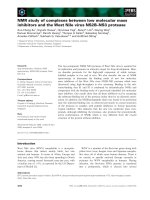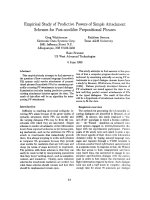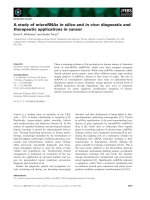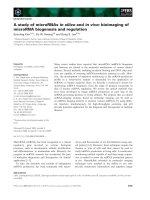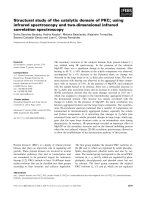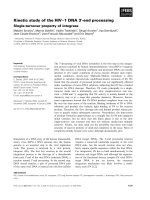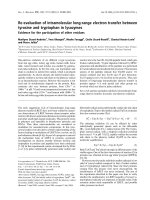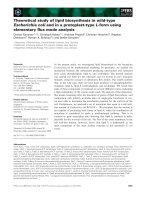Báo cáo khoa học: "Preliminary study of the monoterpene response of three pines to Ophiostoma clavigerum (Ascomycetes : Ophiostomatales) and two chemical elicitors" pot
Bạn đang xem bản rút gọn của tài liệu. Xem và tải ngay bản đầy đủ của tài liệu tại đây (665.78 KB, 12 trang )
Original
article
Preliminary
study
of
the
monoterpene
response
of
three
pines
to
Ophiostoma
clavigerum
(Ascomycetes :
Ophiostomatales)
and
two
chemical
elicitors
F
Lieutier
AA
Berryman
JA
Millstein
1
INRA,
Ardon
45160
Olivet,
France;
2
Washington
State
University,
Department
of
Entomology,
Pullman,
WA
99164,
USA
(Received
3
August
1990;
accepted
15
March
1991)
Summary —
The
monoterpene
response
of
phloem
and
sapwood
of
individual
pines
belonging
to
3
species
(Pinus
contorta,
Pinus
ponderosa
and
Pinus
monticola)
to
inoculation
with
Ophiostoma
cla-
vigerum
and
injection
with
chitosan,
a
proteinase
inhibitor-inducing
factor
and
a
control
buffer,
was
investigated
quantitatively
and
qualitatively.
The
total
quantity
of
monoterpene
in
the
reactive
tissues
increased
with
each
treatment
but
to
different
levels.
In
each
tree,
the
monoterpene
composition
of
the
reactive
tissues
differed
from
that
of
the
unwounded
tissues,
but
was
the
same
whatever
the
treatment,
even
in
the
case
of
an
injection
with
buffer
control.
In
addition,
phloem
and
sapwood
re-
sponses
were
qualitatively
identical
although
constitutive
compositions
differed
greatly.
The
compo-
sition of
reactive
tissues
was
not
very
different
from
that
of
unwounded
sapwood.
The
direction
of
variation
of
each
monoterpene
from
unwounded
to
reactive
tissues
differed
according
to
the
particu-
lar
tree.
Only
phellandrene
+
limonene
reacted
consistently.
From
these
results
we
cannot
conclude
that
chitosan
is
a
natural
elicitor,
and
the
non-specificity
of
the
response
for
the
aggression
favors
the
hypothesis
that
an
elicitor
originates
from
the
tree
itself.
Because
of
this
non-specificity,
and
the
fact
that
the
three
trees
responded
in
a
qualitatively
different
manner,
we
suggest
that
the
qualitative
monoterpene
response
of
the
tree
is
not
adapted
to
any
specific
aggressor
even
though
these
trees
are
usually
hosts
of
the
same
bark
beetle-fungus
complex.
Thus,
the
role
of
monoterpenes
in
the
in-
duced
defensive
response
is
very
likely
a
quantitative
and
dose-dependent
relationship.
monoterpenes
/
Pinus
contorta
/
Pinus
ponderosa
/
Pinus
monticola
/
Ophiostoma
clavige-
rum
/
chemical
elicitors
/
defense
reaction
/
gas
chromatography
Résumé —
Étude
préliminaire
de
la
réponse
monoterpénique
de
trois
pins
à
Ophiostoma
cla-
vigerum
(Ascomycètes :
Ophiostomatales)
et
à
deux
éliciteurs
chimiques.
La
réponse
mono-
terpénique
du
phloème
et
de
l’aubier
de
3
arbres
appartenant
aux
espèces
Pinus
contorta,
Pinus
ponderosa
et
Pinus
monticola
a
été
étudiée
d’un
point
de
vue
quantitatif
et
qualitatif,
après
des
ino-
culations
du
champignon
O
clavigerum
et
des
injections
de
chitosane,
d’un
facteur
induisant
une
inhibition
de
protéinase
(PIIF)
et
d’une
solution
tampon
témoin.
La
quantité
totale
de
monoterpènes
(hydrocarbures)
mesurée
après
3,
7
ou
14 j
dans
les
tissus
réactionnels
augmente
après
chaque
traitement,
mais
atteint
des
niveaux
différents,
le
plus
élevé
étant
obtenu
après
inoculations
du
champignon.
Dans
le
cas
du
chitosane,
la
réponse
est
quantitativement
proche
de
celle
dirigée
contre
O
clavigerum
chez
P
ponderosa,
mais
ne
diffère
pas
de
celle
dirigée
contre
le
PIIF
et
la
solu-
tion
tampon
chez
les
2
autres
arbres
(tableau
I).
Dans
chaque
arbre,
la
composition
monoterpénique
des
tissus
réactionnels
diffère
de
celle
des
tissus
non
altérés,
mais
s’avère
semblable
quel
que
soit
le
traitement,
même
avec
les
inoculations
de
tampon
témoin
(tableau
II et
fig
1).
De
plus,
les
réponses
du
phloème
et
de
l’aubier
sont
qualitativement
identiques,
bien
que
leur
composition
initiale
soit
très
différente.
La
composition
des
tissus
réactionnels
n’est
en
outre
pas
très
différente
de
celle
de
l’aubier
inaltéré
(fig
1).
Le
sens
de
variation
de
chaque
monoterpène
entre
le
tissu
inaltéré
et
le
tissu
réaction-
nel
varie
selon
l’arbre
considéré;
seul
le
groupe
phéllandrène
+
limonène
réagit
toujours
dans
le
même
sens
(fig
2).
Il
n’est
pas
possible
de
conclure
de
ces
résultats
que
le
chitosane
est
un
éliciteur
naturel,
et
la
non-
spécificité
de
la
réponse
vis-à-vis
de
l’agresseur
est
en
faveur
d’une
hypothèse
qui
situerait
dans
l’arbre
lui-même
l’origine
de
l’éliciteur.
À
cause
de
la
non-spécificité
de
la
réponse
et
du
fait
que
les
3
arbres
réagissent
différemment
d’un
point
de
vue
qualitatif,
il
est
suggéré
que
la
réponse
monoterpé-
nique
qualitative
d’un
arbre
n’est
pas
adaptée
à
un
agresseur
particulier,
bien
que
ces
arbres
soient
des
hôtes
habituels
du
même
couple
scolytide-champignon.
Ainsi,
le
rôle
des
monoterpènes
dans
la
réaction
de
défense
induite
est
très
probablement
de
nature
quantitative
et
dépendrait
de
la
dose
ac-
cumulée.
monoterpène
/
Pinus
contorta
/
Pinus
ponderosa
/
Pinus
monticola
/ Ophiostoma
clavigerum
/
éliciteur
chimique
/
réaction
de
défense
/
chromatographie
en
phase
gazeuse
INTRODUCTION
The
fungus
Ophiostoma
clavigerum
(Robinson-Jeffrey
and
Davidson)
Upad-
hyay
plays
a
decisive
role
in
the
mecha-
nisms
of
establishment
of
the
bark
beetle
Dendroctonus
ponderosae
Hopk
in
North
American
pines,
particularly
Pinus
contorta
var
latifolia
Engelmann,
Pinus
ponderosa
Lawson
and
Pinus
monticola
Douglas
(Reid et
al,
1967;
Safranyik
et
al,
1975;
Shrimpton,
1978;
Raffa
and
Berryman,
1983).
During
bark
beetle
attacks,
this
fun-
gus
stimulates
host
parenchymal
cells
to
produce
resin
which
impregnates
the
tis-
sues
located
around
the
site
of
attack
(Reid
et al,
1967;
Berryman,
1969;
Lieutier
and
Berryman,
1988).
This
induced
reac-
tion
is
the
main
line
of
tree
defense
against
the
attack
of
the
bark
beetle
and
its
associated
fungus.
However,
the
nature
and
the
origin
of
the
chemical
elicitor
re-
sponsible
for
the
stimulation
of
the
paren-
chyma
cells
is
not
clear.
In
a
previous
paper,
we
reported
the
histological
changes
induced
in
the
reac-
tive
tissues
of
these
3
pine
species
by
arti-
ficial
inoculations
of
O
clavigerum
and
in-
jections
of
2
chemical
elicitors,
chitosan
and
a
proteinase
inhibitor-inducing
factor
(PIIF)
(Lieutier
and
Berryman,
1988).
Here
we
demonstrate
both
qualitative
and
quan-
titative
changes
in
monoterpenes
induced
in
the
same
tissues
by
the
same
inocula-
tions
and
injections.
Note
that
chitosan
is
a
mixture
of
β-(1,4)
glucosamine
polymers
which
are
constituents
of
arthropod
integu-
ments
and
of
most
fungal
cell
walls
(Had-
wiger
and
Beckman,
1980).
PIIF
is
com-
posed
of
pectic
oligomeric
fragments
derived
from
plant
cell
walls,
the
most
ac-
tive
being
α-(1,4)
galacturonic
acid
poly-
mers
and
oligomers
(Ryan
et
al,
1985).
Both
chitosan
and
PIIF
are
possible
elici-
tors
of
induced
responses
in
plants
natural-
ly
attacked
by
insects
and
fungi
(Hadwiger
et
al,
1981;
Walkers-Simons
et
al,
1984;
Green
and
Ryan,
1972).
Quantitative
and
qualitative
monoter-
pene
modifications
in
response
to
the
at-
tack
of
bark
beetles
and
associated
fungi
have
been
reported
in
conifers
by
several
authors.
Shrimpton
(1973),
Raffa
and
Ber-
ryman
(1982a),
Schuck
(1982)
and
De-
lorme
and
Lieutier
(1990)
noted
an
in-
crease
of
the
total
monoterpene
content
of
phloem
and
sapwood
in
the
induced
reac-
tions
of
P
contorta,
Abies
grandis
(Lindley),
Picea
abies
Karst
and
Pinus
sylvestris
L,
respectively.
Miller
et al
(1986)
reported
a
greater
increase
in
the
total
monoterpene
content
of
Lodgepole
pine
phloem
in
re-
sponse
to
chitosan
than
to
either
PIIF
or
O
clavigerum.
Qualitative
changes
in
the
monoterpene
fraction
of
the
phloem
were
observed
by
Russel
and
Berryman
(1976)
and
Raffa
and
Berryman
(1982a)
in
A
grandis,
by
Raffa
and
Berryman
(1982b)
in
P contorta,
by
Cook
and
Hain
(1985)
in
Pi-
nus
taeda
L
and
by
Delorme
and
Lieutier
(1990)
in
P
sylvestris.
In
the
last
2
cases,
the
qualitative
changes
were
the
same
for
a
given
tree
for
all
treatments
(ie,
2
differ-
ent
strains
of
the
same
fungus
in
P
taeda,
3
different
fungus
species
and
1
beetle
in
P
sylvestris).
Shrimpton
(1973)
was
unable
to
observe
any
qualitative
changes
in
P
contorta
sapwood,
with
the
exception
of
β-
phellandrene
after
natural
attacks
by
D
ponderosae.
However,
Schuck
(1982)
re-
ported
changes
in
some
monoterpene
components
of
P
abies
sapwood
after
wounding.
MATERIALS
AND
METHODS
The
experimental
devices
and
techniques
were
previously
described
by
Lieutier
and
Berryman
(1988).
One
specimen
of
each
tree
species
(P
contorta,
P
ponderosa,
P
monticola,
=
30
cm
diameter
breast
height
from
an
even-aged
mixed
conifer
stand)
received
a
total
of
12
inocu-
lations
(4
treatments
replicated
thrice)
in
July
1985
at
breast
height
using
the
cork-borer
tech-
nique
(Wright,
1933;
Wong
and
Berrryman,
1977).
The
first
treatment
was
inoculation
with
O
clavigerum,
the
second
with
chitosan,
and
the
third
with
PIIF.
Fungal
cultures
were
10-15
d
old.
The
chemical
solutions
consisted
of
a
ni-
trous
acid
cleaved
crab
shell
chitosan
and
a
raw
PIIF
extract
from
tomato
plants
dissolved
in
0.05
M
sterile
phosphate
buffer
(pH
7)
at
the
rate
of
1
mg/ml.
The
fourth
treatment
was
an
injection
of
the
sterile
buffer
alone.
All
inoculations
consist-
ed
of
100
μl
of
chemical
solution
or
a
5-mm
plug
of
agar
containing
fungal
mycelia.
On
each
sam-
pling
occasion
(3,
7
and
14
d
after
treatments),
one
sample
of
each
treatment
was
taken
on
each
tree.
Reactive
phloem
(with
cambium)
and
sapwood
were
removed
and
cut
longitudinally
in
half.
One
half
was
immersed
in
a
cupric
acetate
solution
for
histological
observations
(Lieutier
and
Berryman,
1988)
and
the other
was
immedi-
atly
placed
on
dry-ice
and
stored
at
-60
°C.
Two
wk
after
treatment,
samples
of
unwounded
phloem
and
sapwood
were
also
collected
and
stored
in
the
same
manner.
Monoterpene
analyses
were
performed
on
samples
collected
after
3
and
14
d.
Samples
col-
lected
14
d
after
treatment
were
divided
into
3
20-mm
pieces,
starting
at
the
point
of
inocula-
tion
and
working
away
from
the
wound,
giving
sub-samples
at
0-20
mm,
20-40
mm,
and
40-
60
mm
Three-d-old
samples
consisted
of
a
sin-
gle
0-20
mm
piece.
Each
phloem
sub-sample
was
finely
chopped
and
then
shaken
in
10
ml
pentane
for
24
h.
The
extracts
were
filtered
by
flash
chromatography
in
silica-gel
G
which
was
rinsed
thrice
in
pentane.
They
were
concentrat-
ed
under
a
stream
of
nitrogen
to
0.5,
1
or
2
ml
according
to
the
richness
in
total
monoterpenes.
Analyses
were
performed
on
a
Perkin-Elmer
Sigma-3
gas
chromatograph
equipped
with
a
flame
ionization
detector
and
a
30
m
x
0.2
mm
capillary
column
(Supelco
SE-30).
The
carrier
gas
was
helium
at 1.1
ml/min
at 18
psi.
The
col-
umn
temperature
program
was
80
°C
for
14
min,
a
rise
of
20°
per
min
to
100
°C,
then
100
°C
for
40
min.
The
injector
and
detector
temperatures
were
constant
at
250
°C.
Three
replicates
were
performed
for
each
sub-sample.
Peaks
were
identified
by
comparison
with
the
retention
times
of
pure
monoterpenes
added
to
the
samples
and
by
enhancement
after
these
additions.
For
P
contorta,
comparisons
were
also
made
with
mass
spectrography
results
from
Raffa
and
Ber-
ryman
(1982b).
The
quantitative
values
were
de-
termined
by
means
of
an
electronic
digital
inte-
grator
using
p-cymene
as
an
internal
standard
(this
terpene
was
found
to
be
lacking
in
prelimi-
nary
chromatograms).
The
monoterpene
compositions
of
the
sam-
ples
were
compared
by
principal
component
analysis
(PCA),
for
each
tree
separately,
and
considering
only
monoterpenes
which
were
present
at
levels of
0.5%
or
greater
in
each
sam-
ple.
This
analysis
was
carried
out
with
SAS
soft-
ware
(SAS
Institute).
In
the
present
study,
each
tree
species
was
represented
by
only
one
individual.
However,
our
aim
was
not
to
define the
qualitative
re-
sponse
of
these
species
but
rather
to
compare
the
terpene
composition
of
responding
tissues
with
that
of
unwounded
tissues
of
the
same
tree.
Although
there
is
a
great
deal
of
variation
in
the
monoterpene
composition
of
conifer
spe-
cies
(see,
for
example,
Cates
and
Alexander,
1982),
variations
between
species
are
much
greater
to
the
extent
that
they
can
be
used
as
taxonomic
characteristics
(Zavarin
et al,
1977).
Our
study
was
designed
to
examine
the
ex-
tremes
of
variability
in
the
defensive
reaction
to
a
pathogen
and
2
elicitors.
RESULTS
As
the
extracts
were
filtered
on
silica
gel,
oxygenated
compounds
were
probably
lost
from
the
samples.
Thus,
in
the
follow-
ing,
the
word
"total
monoterpene"
refers
only
to
hydrocarbides
which
in
fact
corre-
spond
to
most
of
the
monoterpene
com-
pounds.
Concentrations
of
total
monoterpenes
(hydrocarbides)
in
the
different
phloem
and
sapwood
samples
are
presented
in
ta-
ble
I.
As
we
have
only
1
tree
per
species,
between-tree
comparison
of
absolute
val-
ues
is
not
possible.
We
therefore
compare
values
between
treatments
within
trees.
O clavigerum
generally
induced
a
higher
accumulation
of
monoterpenes
than
the
chemical
treatments.
In
P
ponderosa
how-
ever,
the
quantitative
response
to
chitosan
was
often
close
to
the
response
to
the
fun-
gus.
The
terpene
accumulations
induced
by
PIIF
and
buffer
alone
were
always
less
than
that
induced
by
the
fungus.
They
were
also
less
than
that
induced
by
chito-
san
in
P
ponderosa
(phloem
and
sap-
wood,
14
d
after
injury)
and
in
the
phloem
of
P
monticola.
Seventeen
different
peaks
(not
always
present)
were
obtained
by
gas
chromato-
graphy
when
reactions
were
compared
with
unwounded
tissue.
One
peak
was
heptane,
12
were
monoterpenes,
and
4
(probably
monoterpenes)
unidentified
peaks
were
labelled
T1
to
T4.
β-
phellandrene
and
limonene
made
up
a
sin-
gle
peak,
but
P
contorta
contains
mainly
β-
phellandrene
(Raffa
and
Berryman,
1982b;
Smith,
1983)
and
P ponderosa
mainly
lim-
onene
(Smith,
1966).
As
an
example,
table
II
gives
the
monoterpene
percentages
for
the
response
of
the
trees
to
fungus
after
14
d
in
comparison
with
unwounded
tis-
sues.
In
this
table,
some
major
differences
can
be
noticed
between
reactive
and
un-
wounded
tissue.
Figure
1
allows
a
general
qualitative
comparison
between
treat-
ments,
dates,
tissues,
and
distance
from
the
inoculation
point
for
each
tree.
The
first
axis
of
the
PCA
(fig
1)
ex-
plained
58.6,
72.5
and
55.6%,
the
second
axis
20.8,
13.1
and
21.8%
and
the
third
axis
7.2, 6.9
and
9.9%
of
the
variability,
re-
spectively
in
P
contorta,
P
ponderosa
and
P
monticola.
The
first
axis
compared
un-
wounded
phloem
to
reactive
tissues
and
can
be
called
the
reaction
axis.
In
P
pon-
derosa
and
P
monticola,
the
second
axis,
with
the
first,
separated
unwounded
sap-
wood
from
reactive
tissues.
In
P
contorta,
unwounded
sapwood
was
separated
from
reactive
tissues
by
the
third
axis.
Thus,
3
main
types
of
monoterpene
composition
were
identified:
unwounded
phloem,
un-
wounded
sapwood,
reactive
tissues
(phloem
and
sapwood
together)
(fig
1;
ta-
ble
II).
In
all
trees
and
in
all
3
axes,
reactive
phloem
could
not
be
separated
from
reac-
tive
sapwood.
In
addition,
the
composition
of
reactive tissue
did
not
appear
very
dif-
ferent
from
that
of
unwounded
sapwood,
with
only
small
differences
occurring
in
the
concentration
of
some
monoterpenes
(ta-
ble
II).
The
changes
in
phloem
composition
induced
by
treatments
are
summarized
in
figure
2,
the
response
to
fungus
inocula-
tion
after
14
d
being
chosen
as
being
re-
presentative
of
all
treatments
(cf,
fig
1).
Monoterpene
fractions
changed
differently
different
tree
species,
except
for
β-
phellandrene
+
limonene
which
always
de-
creased.
Some
reactive
phloem
samples
had
a
monoterpene
composition
similar
to
unwounded
phloem
(fig
1),
but
always
in
parts
of
the
reaction
most
distant
from
the
point
of
inoculation
or
injection;
eg,
PIIF
(20-40
mm
after
14
d)
and
buffer
(20-40
mm
after
14
d)
from
Lodgepole
pine
phloem.
In
addition
to
the
3
main
types
of
monoterpene
composition,
some
phloem
samples
appeared
intermediate
between
unwounded
phloem
and
reactive
tissues
(fig
1).
These
also
originated
from
parts
of
the
reaction
distant
from
the
point
of
inocu-
lation
or
injection;
eg,
chitosan
(20—40
mm
after
14
d)
from
Lodgepole
pine,
chitosan
(40-60
mm
after
14
d)
and
buffer
(20-40
mm
after
14
d)
from
Ponderosa
pine,
chit-
osan
(20-40
mm
after
14
d)
and
PIIF
(20-
40
mm
after 14
d)
from
Monticola
pine.
In
these
intermediate
samples,
the
ratio
of
some
monoterpenes
was
similar
to
that
of
unwounded
phloem,
the
ratio
of
others
was
similar
to
that
of
reactive
phloem,
while
others
had
a
ratio
intermediate
be-
tween
the
2
categories
of
phloem.
The
fungus
sample
(40-60
mm
after
14
d)
in
P
ponderosa
and
the
buffer
sample
(20-40
mm
after
14
d)
in
P
monticola
were
atypical,
not
being
separated
from
un-
wounded
or
reactive
phloems
by
axis
1
but
by
axis
2.
In
fact,
these
2
samples
differed
from
their
respective
group
by
1
terpene
(β-pinene
in
P
ponderosa
and
T3
in
P monticola)
which
had
an
"abnormally"
high
concentration.
In
the
case
of
P
contorta,
it
was
possi-
ble
to
recognize
3
subgroups
inside
the
re-
active
samples
(fig
1).
One
consisted
of
all
reactive
sapwood
and
phloem
samples
re-
sulting
from
fungus
inoculation
after
14
d;
these
samples
had
the
highest
values
along
axis
1.
The
2
others included
reac-
tive
phloem
after
3
d
or
phloem
treated
by
buffer,
PIIF
or
chitosan,
the
value
on
axis
1
being
lower
than
the
previous
subgroup.
It
was
not
possible,
however,
to
recognize
such
subgroups
in
P
ponderosa
and
P
monticola.
INTERPRETATION
AND
DISCUSSION
Comparison
between
treatments
The
increase
in
total
monoterpenes
(hydro-
carbides)
after
treatment
is
in
agreement
with
all
previous
results
of
phloem
and
sapwood
reactions
in
different
conifer
spe-
cies
(Shrimpton,
1973;
Russel
and
Berry-
man,
1976;
Raffa
and
Berryman,
1982a,
b;
Schuck,
1982;
Miller
et al,
1986;
Delorme
and
Lieutier,
1990).
We
observed
differ-
ences
in
the
responses
of
a
given
tree
to
fungus,
chitosan,
PIIF
or
buffer,
the
former
quantitative
treatment
inducing
a
higher
accumulation
of
resins.
Chitosan
induced
a
quantitative
reponse
comparable
with
that
induced
by
the
fungus,
or
higher
than
that
induced
by
PIIF
and
buffer,
only
in
some
cases.
Our
results
are
thus
not
in
a
com-
plete
agreement
with
those
of
Miller
et
al
(1986)
and
with
our
previous
histological
observations
in
suggesting
a
possible
role
of
chitosan
as
natural
elicitor
of
defensive
metabolism
in
conifers
(Lieutier
and
Berry-
man,
1988).
In
considering
the
qualitative
response,
we
note
that
situations
where
the
monoter-
pene
composition
of
the
reactive
tissues
was
similar
to
that of
unwounded
tissues
or
was
intermediate,
were
all
found
in
sam-
ples
collected
far
from
the
point
of
aggres-
sion.
This
allows
us
to
consider
these
situ-
ations
as
either
outside
the
reaction
or
being
an
incomplete
reaction.
This
opinion
is
strengthened
by
the
fact
that
the
total
concentration
of
monoterpenes
in
these
cases
was
similar
to
that
of
unwounded
tis-
sues.
On
the
contrary,
in
situations
close
to
the
point
of
aggression,
all
reactions
clearly
differed
qualitatively
from
unwound-
ed
phloem.
Moreover,
they
all
had
the
same
qualitative
composition.
Each
of
the
trees
responded
in
a
different
way.
Howev-
er,
we
can
conclude
that
the
responding
tissues
of
a
given
tree
all
have
the
same
monoterpene
composition
irrespective
of
treatment,
and
that
this
composition
differs
from
the
unwounded
tissues
of
the
same
tree.
The
conclusion
that
the
reaction
is
non-
specific
for
the
agression
supports
the
re-
sults
of
Cook
and
Hain
(1985),
with
Loblol-
ly
pine
and
2
strains
of
Ophiostoma
minus,
and
of
Delorme
and
Lieutier
(1990)
with
Scots
pine
and
3
different
fungi
and
1
bee-
tle
species.
In
his
histological
studies,
Mul-
lick
(1977)
suggested
that
response
to
inju-
ry
is
not
in
defense
but
rather
to
restore
tissues
and
block
sapwood
conduction,
processes
which
are
inherent,
and
not
spe-
cific
as
to
the
incitant.
However,
we
need
more
information
to
suggest
if
such
a
hy-
pothesis
is
the
case
after
beetle-
fungus
at-
tack.
This
non-specificity,
together
with
the
fact
that
we
found
sterile
phosphate
buffer
inducing
the
same
qualitative
response,
make
it
difficult
to
prove
the
role
of
chito-
san
and
PIIF
as
natural
elicitors.
Moreover,
it
favors
the
hypothesis
that
the
elicitor
originates
from
the
tree.
Nevertheless,
Raf-
fa
and
Berryman
(1982a)
found
that
mono-
terpene
composition
of
the
reaction
of
Abies
grandis
induced
by
inoculations
with
Trichosporium
symbioticum
Wright
differed
significantly
from
uninjured
phloem
in
terms
of
many
compounds,
while
the
com-
position
of
the
reaction
to
mechanical
wounding
differed
significantly
from
un-
wounded
phloem
by
only
one
compound.
Thus
the
reaction
to
fungal
inoculation
was
qualitatively
different
than
to
mechanical
wounding.
As
a
consequence,
our
results
in
pines
do
not
agree
with
those
of
Raffa
and
Berryman
(1982a)
in
firs.
Comparison
between
tissues
The
monoterpene
composition
of
reactive
tissue
was
similar
for
phloem
and
for
sap-
wood
in
all
3
species,
but
the
composition
of
constitutive
tissues
was
different.
Thus,
the
reaction
state
of
tissues
can
be
charac-
terized
by
a
well-defined
monoterpene
composition
in
a
particular
tree,
and
this
does
not
depend
on
the
initial
composition
of
the
tissue.
Shrimpton
(1973)
did
not
find
significant
qualitative
changes
in
the
sap-
wood
of
P
contorta
in
response
to
attacks
by
D
ponderosa.
This
is
explained
by
the
fact
that
reactive
sapwood
had
a
composi-
tion
close
to
that
of
unwounded
sapwood.
Shrimpton
(1973)
only
found
an
increase
in
β-phellandrene,
which
is
contrary
to
our
results,
but
this
may
be
due
to
between-
tree
variation
in
the
qualitative
response,
as
observed
by
Schuck
(1982)
in
the
sap-
wood
of
P
abies
and
by
Delorme
and
Lieu-
tier
(1990)
in
the
phloem
of
P sylvestris.
The
existence
of
a
defined
monoter-
pene
composition
of
reactive
tissues
for
a
given
tree,
whatever
the
tissue,
fits
the
hy-
pothesis
that
neosynthesis
is
from
cells
dif-
ferent
from
those
responsible
for
the
syn-
thesis
of
constitutive
resin.
This
is
in
agreement
with
the
ideas
of
Reid
et
al
(1967),
Berryman
(1969),
Cheniclet et
al
(1988)
and
Lieutier
and
Berryman
(1988),
who
suggested
that
parenchymal
cells
were
responsible
for
neosynthesis.
Our
re-
sults
can
be
explained
by
the
intervention
of
an
elicitor
whose
"message"
could
be
read
by
any
target
cell.
Indeed,
Cheniclet
et
al
(1988)
suggested
that
the
neosynthe-
sis
against
a
beetle-associated
fungus
in
Pinus
pinaster
is
preceded
by
the
reactiva-
tion
of
previously
inactive
cells.
Comparison
between
trees
In
response
to
aggressors,
each
tree
re-
sponded
in
a
different
manner.
There
were
no
between-tree
similarities
in
the
mono-
terpene
response.
Indeed,
only
one
ter-
pene
varied
in
the
same
direction
(de-
crease)
in
the
3
trees.
The
modification
of
the
monoterpene
ratio
in
response
to
O
clavigerum
was
thus
different
in
each
tree
although
they
are
all
hosts
of
D
pondero-
sae
and
O
clavigerum.
Russel
and
Berryman
(1976),
Bordasch
and
Berryman
(1977)
and
Raffa
and
Berry-
man
(1982a)
have
reported
that
the
de-
fense
reactions
of A
grandis
to
T
symbioti-
cum
contain
a
higher
relative
concentration
of
the
terpenes
which
are
least
favorable
to
Scolytus
ventralis
LeConte,
the
beetle
associated
with
T symbioticum.
Conversely,
the
monoter-
penes
least
repellent
to
this
beetle
decline
in
the
defense
reaction
(Bordasch
and
Berryman,
1977).
In
our experiments,
how-
ever,
the
3
pines
did
not
exhibit
a
consis-
tent
differential
response
to
O
clavigerum.
Moreover,
resistance
of
P
ponderosa
to
Dendroctonus
brevicomis
LeConte
seems
to
be
associated
with
limonene
and
myr-
cene
concentrations
(Smith,
1966);
limo-
nene
is
the
most
toxic
monoterpene
to
this
beetle,
followed
by
Δ3-carene
and
myr-
cene
(Smith,
1965).
In
our
P
ponderosa
samples,
however,
myrcene
and
Δ3-
carene
increased
while
limonene
de-
creased.
Raffa
and
Berryman
(1982b)
found
that
the
percentages
of
α-pinene
and
limonene
increase
while
Δ3-carene
decreases
in
the
response
of
P
contorta
to
O
clavigerum
while
in
our
experiment
con-
centrations
of
α-pinene
and
Δ3-carene
both
increased.
These
results
suggest
that
between-tree
variability
in
monoterpene
composition
is
the
rule
in
the
response
of
P
contorta,
as
is
also
true
for
P
abies
(Schuck,
1982)
and
P
sylvestris
(Delorme
and
Lieutier,
1990).
Consequently,
the
qualitative
monoter-
pene
response
of
conifers
does
not
seem
to
be
adapted
to
the
species
of
aggressor.
Instead,
the
role
of
monoterpene
in
the
in-
duced
reponse
of
conifers
to
aggression
is
probably
quantitative
and
dose-dependent,
as
previously
suggested
(Raffa
and
Berry-
man,
1982a,
b;
Delorme
and
Lieutier,
1990).
ACKNOWLEDGMENTS
This
work
was
conducted
as
part
of
Ac-
tion Thématique
Programmée
CNRS-INRA
No
4320.
F
Lieutier’s
visit
to
the
USA
was
sup-
ported
by
a
grant
from
the
Ministry
of
Industry
and
Research
of
France.
The
authors
thank
Y
Hiratsuka,
Northern
Forest
Research
Centre,
Edmonton,
Alberta,
Canada,
LA
Hadwiger
of
the
department
of
plant
pathology,
and
CA
Ryan
of
the
Institute
of
Biological
Chemistry,
Washington
State
University,
Pullman,
for
kindly
providing
the
O
clavigerum
strain,
chitosan,
and
PIIF,
re-
spectively.
We
also
thank
D
Sauvard,
INRA,
Ar-
don,
France,
for
his
help
in
the
treatment
of
the
data.
REFERENCES
Berryman
AA
(1969)
Responses
of
Abies
gran-
dis
to
attack
by
Scolytus
ventralis
(Coleopte-
ra:
Scolytidae).
Can
Entomol
101,
1033-1041
Berryman
AA
(1972)
Resistance
of
conifers
to
invasion
by
bark
beetle-fungus
associations.
Bio
Science
22,
599-601
Bordasch
RP,
Berryman
AA
(1977)
Host
resis-
tance
to
the
fir
engraver
beetle,
Scolytus
ven-
tralis
(Coleoptera:
Scolytidae).
2.
Repellency
of
Abies
grandis
resins
and
some
monoter-
penes.
Can
Entomol 109,
95-100
Cates
RG,
Alexander
H
(1982)
Host
resistance
and
susceptibility.
In:
Bark
Beetles
in
North
American
Conifers
(Mitton
JB,
Sturgeon ,
KB
eds).
Univ
Texas
Press,
Austin,
212-263
Cheniclet
C,
Bernard-Dagan
C,
Pauly
G
(1986)
Terpene
biosynthesis
in
pathological
condi-
tions.
In:
Mechanisms
of
Woody
Plant
De-
fenses
Against
Insects;
Search
for
Pattern
(Mattson
WJ,
Lévieux
J,
Bernard-Dagan
C
eds)
Springer,
117-130
Cook
SP,
Hain
FP
(1985)
Qualitative
examina-
tion
of
the
hypersensitive
response
of
Loblol-
ly
pine
Pinus
taeda
L,
inoculated
with
two
fungal
associates
of
the
southern
pine
beetle,
Dendroctonus
frontalis
Zimmermann
(Cole-
optera:
Scolytidae).
Environ
Entomol
14,
396-400
Delorme
L,
Lieutier
F
(1990)
Monoterpene
com-
position
of
the
preformed
and
induced
resins
of
Scots
pine,
and
their
effect
on
bark
beetles
and
associated
fungi.
Eur
J
For
Pathol
200,
304-316
Green
TR,
Ryan
CA
(1972)
Wound-induced
pro-
teinase
inhibitor
in
tomato
leaves.
Plant
Physiol 51,
19-21
Hadwiger
LA,
Beckman
JM
(1980)
Chitosan
as
a
component
of
pea-Fusarium
solani
interac-
tions.
Plant
Physiol 66,
205-211
Hadwiger
LA,
Beckman
JM,
Adams
MJ
(1981)
Localization
of
fungal
components
in
the
pea-Fusarium
interaction
detected
immuno-
chemically
with
anti-chitosan
and
anti-fungal
cell
wall
antisera.
Plant
Physiol67,
170-175
Lieutier
F,
Berryman
AA
(1988)
Preliminary
his-
tological
investigations
on
the
defense
reac-
tions
of
three
pines
to
Ceratocystis
clavigera
and
two
chemical
elicitors.
Can
J
For
Res
18,
1243-1247
Miller
RH,
Berryman
AA,
Ryan
CA
(1986)
Biotic
elicitors
of
defense
reactions
in
Lodgepole
pine.
Phytochemistry,
25,
611-612
Mullick
DB
(1977)
The
non-specific
nature
of
de-
fense
in
bark
and
wood
during
wounding
in-
sect
and
pathogen
attack.
In:
Recent
Ad-
vances
in
Phytochemistry.
Plenum
Press,
Vol
2, 395-441
Raffa
KF,
Berryman
AA
(1982a)
Accumulation
of
monoterpenes
and
associated
volatiles
fol-
lowing
inoculation
of
grand
fir
with
a
fungus
transmitted
by
the
fir
engraver,
Scolytus
ven-
tralis
(Cloleoptera:
Scolytidae).
Can
Entomol
114, 797-810
Raffa
KF,
Berryamn
AA
(1982b)
Physiological
differences
between
Lodgepole
pines
resist-
ant
and
susceptible
to
the
mountain
pine
beetle
and
associated
microorganisms.
Envi-
ron
Entomol 2,
486-492
Raffa
KF,
Berryman
AA
(1983)
The
role
of
host
resistance
in
the
colonization
behavior
and
ecology
of
bark
beetles
(Coleoptera:
Scolyti-
dae).
Ecol Monogr 53,
27-49
Reid
RW,
Whitney
HS,
Watson
JA
(1967)
Reac-
tions
of
Lodgepole
pine
to
attack
by
Dendroc-
tonus
ponderosae
Hopkins
and
blue
stain
fungi.
Can
J Bot 45, 1115-1126
Russel
CE,
Berryman
AA
(1976)
Host
resis-
tance
to
the
fir
engraver
beetle.
1.
Monoter-
pene
composition
of
Abies
grandis
pitch
blis-
ters
and
fungus-infected
wounds.
Can
J
Bot
54, 14-18
Ryan
CA,
Bishop
PD,
Walker-Simmons
M,
Brown
WE,
Graham
JS
(1985)
Pectic
frag-
ments
regulate
the
expression
of
proteinase
inhibitor
genes
in
plants.
In:
Cellular
and
Mo-
lecular
Biology
of
Plant
Stress.
AR
Liss,
319-
334
Safranyk
L,
Shrimpton
DM,
Whitney
HS
(1975)
An
interpretation
of
the
interaction
between
Lodgepole
pine,
the
mountain
pine
beetle,
and
its
associated
blue
stain
fungi
in
western
Canada.
In:
Management
of
Lodgepole
Pine
Ecosystems
(Baugmartner
DM
ed)
Coop
Ext
Serv,
Wash
State
Univ,
Pullman
406-428
Schuck
HJ
(1982)
The
chemical
composition
of
the
monoterpene
fraction
in
wounded
wood
of
Picea
abies
and
its
significance
for
the
re-
sistance
against
wound
infecting
fungi.
Eur
J
For Pathol 12,
175-181
Shrimptom
DM
(1973)
Extractives
associated
with
the
wound
response
of
Lodgepole
pine
beetle
and
associated
micro-organisms.
Can
J Bot
51,
527-534
Shrimpton
DM
(1978)
Resistance
of
Lodgepole
pine
to
mountain
pine
bettle
infestation.
In:
Theory
and
Practice
of
Mountain
Pine
Beetle
Management
in
Lodgepole
Pine
Forests
(Berryman
AA,
Amman
GD,
Stark
RW,
Kib-
bee
DL,
eds)
College
of
For
Resources,
Univ
Idaho,
Moscow,
ID,
64-76
Smith
RH
(1965)
Effect
of
monoterpene
vapors
on
the
western
pine
beetle.
J
Econ
Entomol
58, 509-510
Smith
RH
(1966)
The
monoterpene
composition
of
Pinus
ponderosa
xylem
resin
and
of
Den-
droctonus
brevicomis
pitch
tubes.
For
Sci 12,
63-68
Smith
RH
(1983)
Monoterpene
of
Lodgepole
pine
xylem
resin:
a
regional
study
in
the
western
United
States.
For
Science
29,
333-
340
Walker-Simmons
M,
Jin
D,
West
CA,
Hadwiger
L,
Ryan
CA
(1984)
Comparison
of
proteinase
inhibitor
inducing
activities
and
phytoalexin
elicitor
activities
of
pure
fungal
endopoly-
galacturonase,
pectic
fragments
and
chito-
sans.
Plant
Physiol76,
833-836
Wong
BL,
Berryman
AA
(1977)
Host
resistance
of
the
fir
engraver
beetle.
3.
Lesion
develop-
ment
and
containment
of
infection
by
resist-
ant
Abies
grandis
inoculated
with
Trichospori-
um
symbioticum.
Can
J
Bot 55,
2358-2365
Wright
E
(1933)
A
cork-borer
method
for
inocu-
lating
trees.
Phytopathology 23,
487-488
Zavarin
E,
Snajberk
K,
Critchfield
WB
(1977)
Terpenoid
chemosystematic
studies
of
Abies
grandis.
Bioch
Syst
Ecol 5,
81-93


